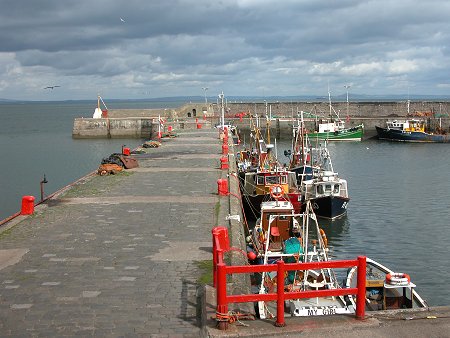
The origins of Port Seton lie a
little inland at the tiny hamlet of Seton, where Seton Palace was
built by the Seton family. Robert Seton, 1st Earl of Winton
began the initial harbour construction and his 2nd son,
George, 3rd Earl of Winton continued and finished it in 1656. It
was used primarily as a fishing harbour, though it also serviced
the Seton estate. The Setons backed the Jacobite
causes in the 1689, 1708, and 1715 uprisings and their estates in
the area were forfeited as a result. The York Buildings Company,
which took over management of the estate's mining interests, built
the Tranent Waggonway in 1722. This was a horse-drawn railway
carrying coal from the pits of Tranent to the Cockenzie harbour.
The 1745 Jacobite uprising the
Battle of Prestonpans took place a mile south of Cockenzie and
close to the line of the waggonway. History was made when the
waggonway was used to transport troops to the battle, marking the
railway's first ever use in warfare. Cockenzie was also home for many
years to boatyards producing fishing vessels and yachts. The sheds
and slipways remain, but the last vessel was produced in the mid
1990s. Fishing remains important to the whole community. This is
obvious from the harbours, unusual along this coast in being home
to more working vessels than pleasure craft. The importance of
fishing is also obvious from the continuing presence of
traditional fish merchants and curers in the village. One of the more obvious recent
developments took place in the 1960s when the Cockenzie Power
Station was built on the coastal site of a disused coal mine just
to the west of Cockenzie and Port Seton. The site was chosen to
make use of the excellent coal supplies available locally, the
good rail links, and the availability of seawater for cooling:
hence the absence of cooling towers. But though the power station
dominates westward views from the village, there are less
attractive neighbours you could have. And and the continuing
presence of the power station has probably helped protect the
communities here from being swamped by their proximity of
Edinburgh, only a dozen miles to the west. As a result the
village retains the sense of a living and working place rather
than a dormitory. In many ways Cockenzie and Port Seton feels much
more like the sort of fishing villages found on the coast of
Aberdeenshire or Moray than somewhere right on the doorstep of
Scotland's booming capital.